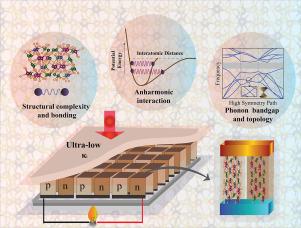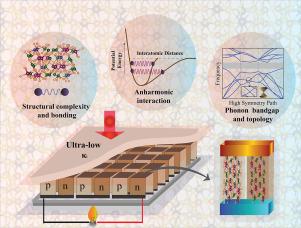Mechanisms and design principles for optimizing lattice thermal conductivity in chalcogenides: A comprehensive review
IF 9.7
2区 材料科学
Q1 MATERIALS SCIENCE, MULTIDISCIPLINARY
引用次数: 0
Abstract
The thermal transport coefficients, especially the lattice thermal conductivity of a material, are crucial in optimizing thermoelectric efficiency and play a significant role in designing future thermoelectric devices. The lattice thermal conductivity () depends on various factors, including complex lattice configuration and disorder, chemical bonding, anharmonicity, and topological behavior of phonons. Heavy rattling atoms in a unit cell impact heat propagation due to small phonon mean free path, boundary scattering, and anharmonic scattering. In addition, the structural modification through ripples, strain, and local distortions can increase phonon scattering. The disorder and dislocations disrupt phonon propagation, while strain manipulates acoustic phonon scattering. Lone pairs and unusual chemical bonding induce lattice softening and localized phonon vibrations that significantly impede phonon transport. The localization and delocalization of charge carriers through antibonding interactions result in ultralow without compromising electron transport properties. The forbidden phonon band gap is another crucial factor that alters the phonon phase space for acoustic-optical interactions, restricting the three-phonon scattering process and emphasizing the vital role of higher-order anharmonic interactions. The emerging concept of the topological behavior (band inversion, Weyl phonon, and nodal lines) of phonons serves as an additional degree of freedom in determining the thermal transport of chalcogenides. Topological phonon points can enhance group velocity through steep linear dispersions or reduce it via flat bands while simultaneously modulating scattering rates due to high phonon density near nodal features. This review integrates experimental and computational insights behind various strategies for chalcogenides, making them future materials for next-generation thermoelectric devices and thermal applications.


硫族化合物中优化晶格热导率的机制和设计原则综述
材料的热输运系数,特别是晶格导热系数,是优化热电效率的关键,在未来热电器件的设计中具有重要作用。晶格热导率(κl - κl)取决于多种因素,包括复杂晶格构型和无序性、化学键、非调和性和声子的拓扑行为。由于声子平均自由程小、边界散射和非谐波散射,单晶胞中的重咔嗒声原子影响热传播。此外,通过波纹、应变和局部畸变引起的结构改变会增加声子散射。无序和位错破坏声子传播,而应变操纵声子散射。孤对和不寻常的化学键机制的存在会导致晶格软化和局部声子振动,从而显著阻碍声子传输。通过反键相互作用,载流子的定域和离域产生了超低的κl - κl而不影响电子输运性质。禁声子带隙是改变声子相空间的另一个关键因素,它限制了声子散射过程,强调了高阶非谐波相互作用的重要作用。声子的拓扑行为(带反转,Weyl声子和节点线)的新概念在确定硫族化合物的热输运中提供了额外的自由度。拓扑声子点可以通过陡峭的线性色散提高群速度或通过平坦带降低群速度,同时由于在节点特征附近的高声子密度而调制散射率。本综述整合了硫族化合物各种策略背后的实验和计算见解,使其成为下一代热电器件和热应用的未来材料。
本文章由计算机程序翻译,如有差异,请以英文原文为准。
求助全文
约1分钟内获得全文
求助全文
来源期刊

Materials Today Physics
Materials Science-General Materials Science
CiteScore
14.00
自引率
7.80%
发文量
284
审稿时长
15 days
期刊介绍:
Materials Today Physics is a multi-disciplinary journal focused on the physics of materials, encompassing both the physical properties and materials synthesis. Operating at the interface of physics and materials science, this journal covers one of the largest and most dynamic fields within physical science. The forefront research in materials physics is driving advancements in new materials, uncovering new physics, and fostering novel applications at an unprecedented pace.
 求助内容:
求助内容: 应助结果提醒方式:
应助结果提醒方式:


